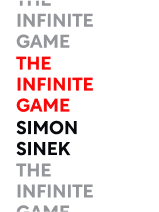

This article is an excerpt from the Shortform book guide to "The Infinite Game" by Simon Sinek. Shortform has the world's best summaries and analyses of books you should be reading.
Like this article? Sign up for a free trial here .
Is The Infinite Game worth reading? What qualities, according to its author Simon Sinek, make for a truly exceptional leader?
The Infinite Game, published in 2018 by Portfolio, an imprint of Penguin Random House, is Sinek’s fifth book. It follows up and continues exploring many of the concepts in the Leaders Eat Last and Start With Why. Throughout these three books, he explores different takes on the idea that what makes a leader exceptional is a commitment to a higher purpose.
This The Infinite Game review takes a look at the book’s inspiration and background, intellectual context, and strengths and weaknesses.
The Infinite Game: Inspiration and Background
The book was inspired by and based on the concepts from James P. Carse’s 1986 book Finite and Infinite Games, which laid out the foundational idea that Sinek builds on—namely, that every interaction we have with others is either part of a finite game, aimed at winning, or an infinite game, aimed at continuing the play. Carse was a theologian and philosopher, and saw infinite and finite games as part of every aspect of life, from religion to romance to geopolitical alliances.
Sinek’s twist applies these concepts to business strategy specifically. While Sinek was not the first to reflect on Carse’s philosophies, they remained somewhat on the fringe of cultural consciousness until Sinek linked them specifically to the world of business and launched them into the public eye again.
Intellectual Context
Sinek’s work fits neatly into a contemporary view of leadership and business strategy that encourages people to think of larger issues more than their own immediate needs, and to focus on long-term rather than short-term concerns in order to find lasting success. Other books that touch on similar concepts include Ego Is the Enemy, The Leadership Challenge, and Built to Last.
Sinek also emphasizes the importance of focusing your efforts on one major, overriding purpose that gives your organization meaning. Other management books that advocate for this include the ones mentioned above as well as Greg McKeown’s Essentialism: The Disciplined Pursuit of Less.
Sinek contrasts his theories with those of Milton Friedman, who was an early advocate of modern capitalism and the idea that self-interested incentives are the backbone of a healthy economy. Sinek argues that you can be successful by rejecting Friedman’s philosophies, and, in fact, that rejecting self-interest can lead to even more success than chasing it.
The Book’s Impact
The book sold well, hitting the number two spot on the New York Times bestseller list in November of 2019. It was his second book to make the list, after Leaders Eat Last.
The book frequently makes lists of recommended business books to read, and was even included on the 2021 U.S. Navy’s Professional Reading Program book list, a list of books that every ship is equipped with and that sailors are encouraged to read (the program’s motto is “Read Well to Lead Well”). (Sinek’s other book, Leaders Eat Last, is also included.)
The Infinite Game launched Sinek to a new level of popularity, paving the way for him to start his own publishing imprint, Optimism Press, in partnership with his longtime publisher Portfolio and under the umbrella of Penguin Random House.
The Book’s Strengths and Weaknesses
Online reviewers who appreciate the book feel its concepts are a new way of thinking about business and success, and they enjoy the way Sinek constructs a clear plan and concrete techniques for developing an infinite mind. Many The Infinite Game reviews say the book is for leaders who aim to be more than just business leaders, but also leaders of humanity. Some note that the concepts outlined in the book apply to peacekeeping missions and society in general, and they argue that if leaders followed its prescripts, the world would be better off.
Online reviewers who find fault with Sinek’s book often argue that the book’s insights aren’t very original, but instead might be found in any self-help business book. Many also say that Sinek cherry-picks examples to support his arguments, and that his concepts don’t work as well in real life as they do in theory. Additionally, some argue that it’s unrealistic to expect business leaders, who are concerned with keeping their organizations viable, to put their own needs aside and focus on the needs of the wider world. Finally, some reviewers find fault with how Sinek has interpreted Carse’s philosophies in the original Finite and Infinite Games that inspired Sinek’s book—for example, critics argue that Sinek’s reliance on the Cold War as an example of an infinite game might not properly represent Carse’s ideas, since wartime activity is inherently a finite game.
Commentary on the Book’s Approach
The book does repackage ideas that can be found in many other management books, but Sinek never claims to be completely original—in fact, he credits Carse’s book as inspiration in the introduction. While his theories mirror those in many other books in the management genre (essentially repackaging effective leadership as different expressions of selflessness), his pairing of management techniques with the idea of an “infinite game” is original.
A more substantial critique is that his examples are occasionally only narrow illustrations of his theories. In practice, alternative examples that might demonstrate his ideas often come with caveats—companies that lived up to his ideas but haven’t succeeded as well as he might have predicted (like TOMS), or companies that succeeded very well and seem to fit with his theories but also benefited from other advantages that can also explain their success (like Apple, which benefited greatly from some luck along the way and whose founder Steve Jobs engaged in some finite, self-centered thinking, especially when Apple was young).
Commentary on the Book’s Organization
The overall flow of Sinek’s book follows this path:
- Sinek opens his book with an overview of finite and infinite games, discussing their definitions and how developing an infinite mindset will bring you more success.
- He introduces his analysis of the five guidelines for an infinite mind (a Just Cause, Trusting Teams, Worthy Rivals, Existential Flex, and Courage).
- He discusses the first element, a Just Cause.
- He departs from the five guidelines to discuss some background economics and a brief history of how finite thinking came to take over the corporate world.
- He includes a chapter discussing employee morale, which is outside the scope of any particular guideline.
- He then discusses the last four guidelines in order.

———End of Preview———
Like what you just read? Read the rest of the world's best book summary and analysis of Simon Sinek's "The Infinite Game" at Shortform .
Here's what you'll find in our full The Infinite Game summary :
- Why businesses who see the game as finite don't survive
- How to develop an infinite mindset that will put you and your organization on a path for long-term success
- How the purpose of business is changing






